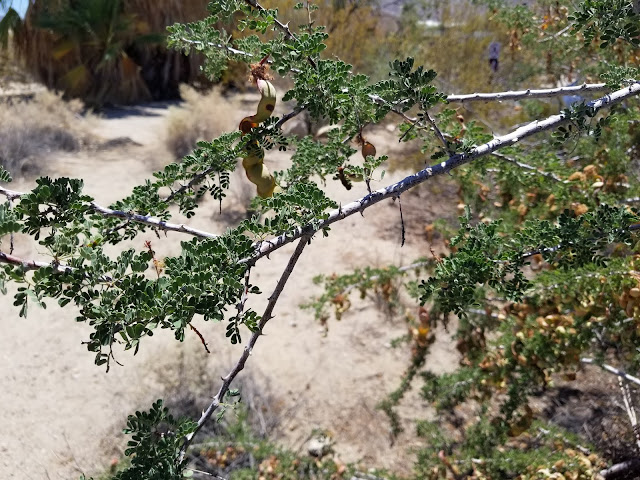Botanical Name: Senegalia Greggii
Common Names: Catclaw, Wait-a-Minute Bush
Alternate Botanical Names: Acacia Greggii
Visual Characteristics: Presenting as a medium sized shrub, casual eyes could mistake Catclaw for one or more or its biome associates, such as Larrea Tridentata or California Juniper. Rains render lush green foliage and can cause young plants to look similar to Ocotillo. As more familarity is achieved, hanging seed pods become noticeable, which turn brown as they mature. Small thorns reside on many of the branches, and easily become entangled in skin, clothing, or fur, giving way to its common name. It is Deciduous, which means many of its leaves are shed in times of drought. This species is susceptible to the host seeking Desert Mistletoe, which can appear as a bundle of deceptively innocent twigs amidst its branches.
Visual Characteristics: Presenting as a medium sized shrub, casual eyes could mistake Catclaw for one or more or its biome associates, such as Larrea Tridentata or California Juniper. Rains render lush green foliage and can cause young plants to look similar to Ocotillo. As more familarity is achieved, hanging seed pods become noticeable, which turn brown as they mature. Small thorns reside on many of the branches, and easily become entangled in skin, clothing, or fur, giving way to its common name. It is Deciduous, which means many of its leaves are shed in times of drought. This species is susceptible to the host seeking Desert Mistletoe, which can appear as a bundle of deceptively innocent twigs amidst its branches.
Native To 29 Palms: Yes
Native To Adjacent Regions: Yes
Native To Adjacent Regions: Yes
Occurance In Neighborhoods: Common
Occurance In Rural Areas: Common
Use by Indigenous Cultures: Information suggests native people gathered only younger seeds, avioding the older, known to be toxic. Many tribes used the twigs for various applications such as baskets, brushes, brooms, bows, small tools and construction material for fences. Other accounts tell of camoflauge, aromatic essences, and grazing of domesticated animals.
Use by Indigenous Cultures: Information suggests native people gathered only younger seeds, avioding the older, known to be toxic. Many tribes used the twigs for various applications such as baskets, brushes, brooms, bows, small tools and construction material for fences. Other accounts tell of camoflauge, aromatic essences, and grazing of domesticated animals.
Sentiments: So quiet she laid among wind and shade, Sitting on sickles cut from its clade, Though unforboding the sit seemed at first, When a nip and a clip slip a rip through her purse, Oh wont you save her, Skin hot in a push, The damsel entangled wait a minute bush.




No comments:
Post a Comment
Note: Only a member of this blog may post a comment.